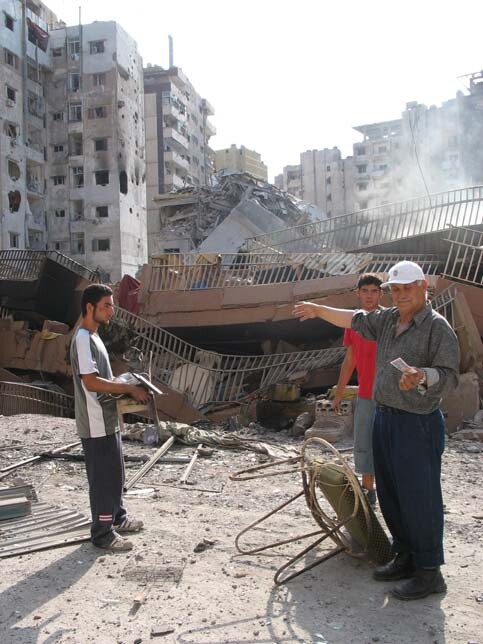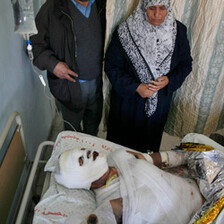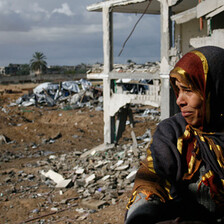Beirut 19 August 2006

Two days ago, driving toward the village of Qana, we saw men at work, creating neatly aligned rows of rectangular cement structures that would soon be ready for burials. On foot, we entered Qana, thinking we should at least identify the site where a massacre had taken place when, on July 30th, an Israeli bomb hit a building that sheltered children as they slept. It took five hours for ambulances to reach them. Statistics differ, but the most recent Human Rights Watch report estimated that twenty-three were killed.
Turning a corner, we saw men arranging white plastic chairs for guests who came to mourn with family members in the funeral tradition. The men sat in front of one home. Women were next door.
Farah and I approached four women sitting quietly and tearfully in a small outdoor patio. They invited us to sit with them. For much of the time, we sat silently. Each time a neighboring woman arrived, the women would stand and embrace one another tearfully. They have borne their pain for eighteen days, since 1:00 a.m. on July 30th when the bomb slammed into the building just across the road from where we sat, the building where their children slept. The funeral was delayed until it would be safe to bring families together and to construct the graves.
Umm Zayneb, the mother of six year old Zayneb, poured out a torrent of words, telling the details of what had happened to Zayneb and entrusting us with her views which we could only barely understand. Our translators were next door, sitting with the men. We could see that Umm Zayneb had suffered injuries. Under her veil, she wore a medical hood and a thick brace encircled her neck. She stiffly shifted her tall, slender body, unable to point across the street to what was once a building where frightened children had huddled together for shelter during the bombing. Surveillance planes must have known that children were in the building. Many times, in the daytime, Zaynab ran back and forth between the house and the shelter . Umm Zaynab said we must be able to see how close she was to her home. Yes, we could see. We listened to the drone of an unmanned surveillance plane still crisscrossing the skies above. Couldn’t they see? What kind of censorship would obscure this information?
“She liked to practice English,” Umm Zaynab told us, her words turning to sobs. “She was happy because she could say English words.” This sentence aroused a new flood of agony. The brace forced her to contain her shudders. She rocked diffidently, overwhelmed with grief.
Umm Zaynab asked one of the children to bring a stack of newspapers and magazines. “Here,” she said, carefully sorting through reports on the massacre at Qana. “This is Zaynab.” Photo after photo showed Zaynab held aloft, lifeless, by a strong, helmeted relief worker who shouted his shock and terrible awe. In another, Zainab lies next to Zahara. The force of the explosion seems to have destroyed the internal organs of the little girls, as they slept. Their bodies are not mutilated.
Next she placed in our hands a framed picture of Zaynab, a curly headed little girl with huge dark eyes posing seriously for the camera. One can only imagine her smile.
“Who are the terrorists?” Umm Zayneb whispered, slowly reaching over to point at Zayneb’s picture. Her eyes held mine as she answered her own question. I heard her say “Bush.” “She is saying that Zayneb and the children aren’t the terrorists,” Farah interjected, understanding more Arabic than me. “She says the real terrorists are the ones who kill children.”
Looking at the burnt and blackened hillsides throughout southern Lebanon, you can only imagine the cedar trees that only one month ago made these hills as green as the hills in Israel.
Cana. New Testament scriptures say that Jesus spent time here. Nearby is a small cave, reputed to mark the site of a wedding feast Jesus had attended. A story tells of Jesus’ mother, Mary, entreating the beloved son to show concern for newly arrived wedding guests. She identified them as people who weren’t being served. She didn’t want them to be excluded, left out. Who would listen to a widow’s concern? Her son must help. The tradition tells of a miracle, of water turned to wine.
Qana. Who will listen to bereaved mothers entreating the heavens for an end to the hellish, fiery explosions that slaughter their children. The facts tell of a massacre, the astonishing technological capacity to identify and then to exclude the children from life itself.
A banner hangs in Qana, addressed to Condoleeza Rice. “Rice, they will not see “our new Middle East.”
Kathy Kelly, is a co-coordinator of Voices for Creative Nonviolence. Her book, Other Lands Have Dreams, is available at www.counterpunch.org. She may be reached at kathy@vcnv.org. On August 17 and 18, she traveled in southern Beirut with three other participants in Voices campaign work who joined international solidarity efforts in Beirut during August, 2006.
Related Links




